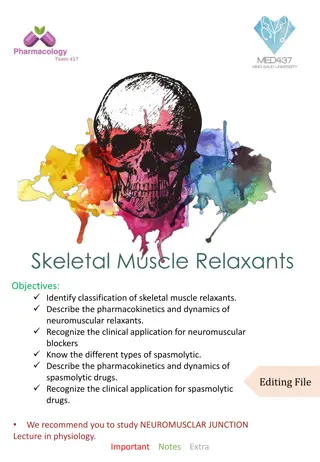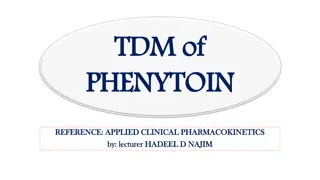Understanding Local Anesthetics: Mechanism, Characteristics, and Pharmacokinetics
Local anesthetics (LAs) block nerve impulse conduction effectively for pain management without motor blockade. Their chemistry, including lipophilic groups and ionizable groups, contributes to their efficacy. LAs have rapid onset, long duration, reversibility, and minimal side effects. Pharmacokinetics depend on dosage, injection site vascularity, and the use of vasoconstrictors to reduce systemic absorption. Overall, LAs play a crucial role in anesthesia with varying characteristics and applications.
Download Presentation

Please find below an Image/Link to download the presentation.
The content on the website is provided AS IS for your information and personal use only. It may not be sold, licensed, or shared on other websites without obtaining consent from the author. Download presentation by click this link. If you encounter any issues during the download, it is possible that the publisher has removed the file from their server.
E N D
Presentation Transcript
LA: Reversibly block impulse conduction along nerve axons & other excitable membrane that utilize Na+ channels for Action Potential generation. Uses: block pain sensation (nociception) from specific area of the body or block sympathetic vasoconstricor impulses to this area. Cocaine was the 1st LA isolated from Coca plant as an ophthalmic anesthetic. Cocaine chronic use psychological dependence (addiction). 2
Followed by procaine and Lidocaine which are the most widely used LA. What characteristics of LAs make them ideal agents for anesthesia? 1- Rapid onset 2- Long Duration of Action 3- Reversible & selective blockade of sensory nerves without motor blockade 4- Minimal local tissue irritation & no systemic toxicities. 3
Chemistry of LA LA are weak bases & available as salts to increase solubility & stability. A local anesthetic consists of: 1. Lipophilic group eg, aromatic rings 2. Intermediate chain (amide or ester) 3. Ionizable group (eg, Tertiary amine) Esters usually have short duration of action LA exist in the body as two forms: 1. Cation (charged): most active form. 2. Uncharged: important for rapid penetration of cell membrane. 4
Medium Short long Medium medium Long Medium Long 6
pharmacokinetics systemic absorption of LA depends on 1. Dosage. 2. Site of injection: vascularity absorption. High vascular areas: tracheal mucosa and intercostal area. Low vascular areas: tendon, dermis, and SC fat. Comparing absorption in other areas: Paracervical > epidural > brachial plexus > sciatic nerve IV administration has the highest systemic absorption 8
3. Drug tissue binding. 4. Local blood flow 5. Use of vasoconstrictors (eg, epinepherine): Vasoconstrictors reduce blood flow systemic absorption. Works for drugs with short or intermediatre duration (procaine, lidocaine, and mepivacaine) but not prilocaine Vasoconstricors enhance neuronal uptake of LA prolong action Also, they reduce systemic toxic effects of LA. They don t work with long-acting drugs (bupivacaine and ropivacaine). 6. Physiochemical property of the drug 9
Distribution Amide LA are widely distributed after IV bolus injection Distribution has 2 phases 1. Initial rapid phase into highly perfused organs (brain, live, kidney) 2. slower phase to moderately perfused organs. (muscle and GI) 10
Metabolism & Excretion Ester-type hydrolyzed rapidly in blood(by pseudocholinesterase) to inactive metabolite. Therefore, they have short plasma t1/2 (< 1 min). amide linkage is hydrolyzed by liver CYP450 with different rates (prilocaine (fastest) > Lidocaine > mepivacaine > ropivacaine > bupivacaine (slowest). Hepatic diseases toxicity of amide type. Example: elimination t1/2 of Lidocaine from 1.6 hr in normal pt. to 6 hr in liver disease pt. Amide LA also affected by enzyme inhibitors. Reduced hepatic blood flow decreases their elimination. 11
contd All are converted to water-soluble metabolites & excreted in urine. Acidification of urine ionization & excretion of LA 12
MOA Primary action is by blocking voltage- gated Na+ channels. Alkaline PH activity of drugs. Inflamed tissues are acidic thus changing the LA (weak bases) to the charged form becoming less lipophillic and less absorbable by tissues. They bind to activated and inactivated channels. (rested channels are resistant) 13
extracellular Ca+ rested channels activity of LA. K+ inactivated channels. Structure-activity characteristics of LA Smaller & more lipophilic LA Faster rate of interaction with Na+ channels Lidocaine, procaine, and mepivacaine are more water-solube than tetracaine, bupivacaine and ropivacaine. The latter agents are more potent and have long duration of action (DOA) These long acting LA also bind more extensively to plasma proteins & can be displaced by other drugs. 14
Other actions on nerves 1- Motor paralysis during surgery 2- Autonomic nerve blockade Disadvantages In Spinal anesthesia, motor paralysis impairs respiratory activity & autonomic blockade hypotension & urinary retention (requires catheterization). 15
Nerve fibers differ in their susceptibility to LA 1- Effect of fiber diameter: Small fibers are blocked 1st . (e.g. C fibers which transmit slow pain). Large and thick fibers (motor neurons) are relatively resistance because the LA takes a longer time in penetrating the full diameter of the nerve. Myelinated fibers are blocked earlier than unmyelinated fibers of the same size. Preganglionic B fibers (myelinated) are blocked before C fibers (unmyelinated) So the chronological order is: 1st small B and C fibers 2nd other sensory fibers 3rd motor neurons 16
2- Effect of firing frequency Blockade by LA is increased at higher frequencies of depolarization. Sensory (pain) fibers have high firing rate & long AP duration, while motor fibers fire at a slower rate & have shorter AP duration. 3- Effect of fiber position in nerve bundle In large nerve trunks, motor nerves are located in the outer portion of the trunk. Thus, they are the 1st to be exposed to LA. In the extremities, proximal sensory fibers are located in the outer portion. So the drug acts 1st proximally then distally. 17
Properties of LAs Plasma t1/2 drug onset duration notes Side effects Rarely used only as spray in UR cocaine M M 1 hr CVS & CNS Restlessness, shivering, anxiety, bradycardia, CO No longer Used procaine M Short <1 hr 18
Widely used + IV in ventricular arrhythmia. Mepivacaine is similar As procaine but < tendency to CNS Lidocaine Rapid M 2 hr spinal & corneal anesthesia. Widely used (long DOA). Ropivacine is similar, with less cardioTox. Amethoc- (tetrac V. Slow Long 1 hr As Lidocaine As Lid but > CVS Bupivacaine Slow Long 2 hr Widely used, not for obstetric (neonatal metHgemia. No VD? MetHgemia Prilocaine M M 2 hr 19
Clinical pharmacology Effective analgesia in specific regions of the body. Route of administration: 1- Topical application (nasal mucosa, wound margins) 2-Injection in the vicinity of peripheral nerve endings (infiltration) & major nerve trunks (blocks) 3- Injection into the epidural such as in labor or subarachnoid spaces (spinal) surrounding the spinal cord for operations done below the level of the umbilicus for example in area L3, L4 for lower limb operations. This method might cause direct neurotoxicity. 4- IV regional anesthesia (Bier block) for surgery < 60 min in limbs. 20
Epidural Spinal 21
Local Infiltration: Extravascular placement of LA in the region to be anesthetized Peripheral Nerve Block: LA injection into tissues around individual nerves or nerve plexuses (e.g. brachial plexus). DOA Short: proc- & chloropro- caine Intermediate: Lid, mepiva- & prilo- caine Long-acting: tetra-, bupiva-, & ropiva- caine. DOA can be prolonged by increasing the Dose + adding vasoconstrictor agent. 23
To increase the onset of LA: add NaHCO3 to LA solution which enhances the buffering media for LA at the site of injection. Repeated injection of LA extracellular acidosis tachyphylaxis Pregnancy increases sensitivity to LA toxicity of LA. Topical LA: eye, ENT & for cosmetic surgery. LA should be able to: 1- rapidly penetrate across the skin or mucosa 2- little tendency to diffuse away from the site of application. 24
Cocaine because of its excellent penetration & local vasoconstrictor effect is used for ENT procedures. Has irritating effect and, therefore, not used for ophthalmic procedure. Other topical: Lidocaine + Vasoconstrictor, tetracaine, pramoxine, dibucaine, benzocaine, & dyclonine. 25
OTHER USES: LAs have membrane-stabilizing effects so Both IV Lidocaine & oral (mexiletine, tocainide) used to treat pt. with neuropathic pain syndrome. Systemic LA: as adjuncts to tricyclic antidepressant (amitriptyline) & anticonvulsant (carbamazepine) combination. 26
Toxicity A- CNS: 1- All LA at low concentration: sleepiness, light headiness, visual & auditory disturbances & restlessness. Early symptoms: tongue numbness + metallic taste. Rare, but High plasma conc. : nystagmus & muscular twitching, then tonic-clonic convulsions. Followed by generalized CNS depression (apnea). You can avoid convulsion by: 1. Giving the smallest dose 2. Avoid inadvertent intravasulcar injection 27
If large dose of LA is required: premedication with benzodiazipine provides prophylaxis 2- Cocaine: widely abuse drug, severe CV toxicity; HTN, arrhythmia, & myocardial Failure. B- Neurotoxicity: direct neuronal toxicity with excessive high concentration Chloroprocaine & Lidocaine are > neurotoxic than others in spinal anesthesia and are avoided for this use. They produce transient radicular irritation (or transient symptoms). 28
C- CVS: direct effect on the heart & smooth muscle & indirect effect on autonomic nervous system(ANS). Depress strength of contraction and cause arteriolar dilatation hypotension Cocaine blocks Norepinephrine uptake: vasoconstriction & HTN + cardiac arrhythmia & ischemia. Bupivacaine is > cardiotoxic than other long- acting LA. Ropivaciane: has CVS & CNS toxicity but less than Bupivacaine. 29
D- Hematologic effects: Large dose of prilocaine: accumulation of Oxidizing Agent (o- toluidine) that convert Hb to metHb. Signs: cyanosis & chocolate-colored. Not recommended in infants. (Benzocaine can also cause metHb). Rx of metHb: IV methylene blue or ascorbic acid. E- Allergic reactions: (only in ester type) Ester-type LAs are metabolized to P-ABA derivatives allergic reactions. 30























